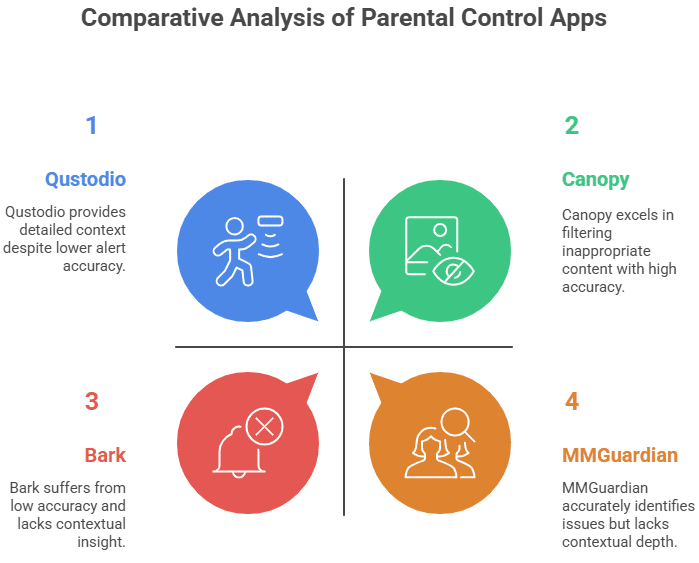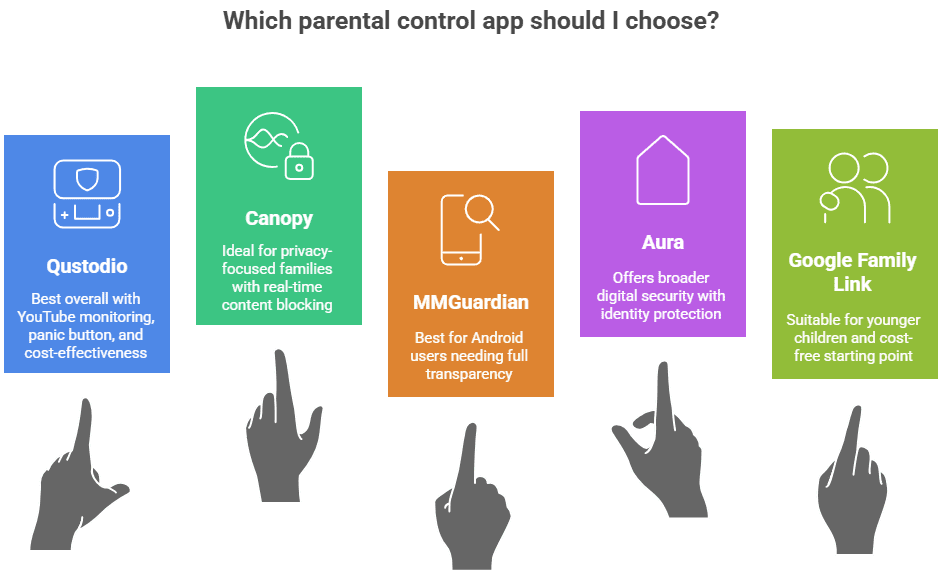Online risks are escalating at a pace that parents cannot ignore. Recent studies reveal that 26.5% of American teens aged 13 to 17 experienced cyberbullying in 2023, up from 23.2% just two years earlier.
Among these cases, over three-quarters involved cruel or hurtful comments posted online, and nearly one in five teens missed school because of harassment. Girls aged 15 to 17 are disproportionately affected, with more than half reporting some form of digital abuse.
With threats ranging from offensive name-calling to the sharing of explicit images without consent, parents need tools that do more than send occasional alerts. While the Bark App remains a popular monitoring solution, it has limitations that push many families to consider alternatives.
The following options provide different strengths, whether you need better iOS compatibility, broader device coverage, or real-time content filtering, so you can find the right fit for your household. Let’s get to it and find the five best alternatives to Bark App.
Table of Contents
- Key Takeaways
- 1. Qustodio: The Most Comprehensive Bark Alternative
- 2. Canopy: The Privacy-Respecting Powerhouse
- 3. MMGuardian: The Android Specialist
- 4. Aura: Beyond Parental Controls
- 5. Google Family Link: The Free Alternative
- Testing Insights: What We Discovered
- Your Family’s Needs: Which Alternative Fits Best?
- Feature Comparison
- Final Verdict: Our Top Recommendation
- Taking Action: Protecting Your Family Today
- Frequently Asked Questions
Key Takeaways
- Cyberbullying affects 26.5% of American teens between the ages of 13 and 17, with YouTube being the most common platform for online harassment.
- Bark provides basic monitoring but lacks full YouTube tracking, real-time filtering, and detailed activity reporting.
- Qustodio offers advanced features including YouTube monitoring, SOS alerts, flexible time limits, and cross-platform support at $8.33 per month.
- Canopy focuses on prevention with AI-powered filtering and sexting blocking, providing strong protection without scanning private messages.
- MMGuardian excels for Android users by providing full message access, deleted text recovery, and app grouping for flexible limits.
- Aura combines parental controls with full identity protection, credit monitoring, VPN, and antivirus for families prioritizing total digital safety.
- Find vetted parental control tools and exclusive discounts in Batten Cyber’s expert-curated marketplace.
1. Qustodio: The Most Comprehensive Bark Alternative
Qustodio consistently ranks as one of the most complete parental control solutions available, offering tools that extend beyond what Bark provides. While Bark focuses primarily on monitoring content and sending alerts, Qustodio equips parents with a broader set of features that help manage and understand their child’s digital life in real time.

Why Parents Switch From Bark to Qustodio
Qustodio addresses several frustrations that many Bark users encounter. One of the most significant is YouTube monitoring. Bark cannot track specific YouTube search terms or videos viewed, which is a major gap given that nearly 79% of teens report encountering cyberbullying on YouTube.
Qustodio fills this gap by providing detailed visibility into every video watched and search performed, making it particularly helpful for parents of younger teens who use YouTube as their primary platform.
Another standout feature is Qustodio’s activity timeline. Instead of receiving scattered alerts with little context, parents can view a chronological snapshot of their child’s entire day online. This makes it easier to identify patterns, such as late-night social media use or repeated visits to concerning websites. Many parents describe this feature as more actionable than Bark’s alert-only system.
Time management is another area where Qustodio excels. Bark offers basic scheduling to block devices during certain hours, but Qustodio allows far more flexibility. Parents can set daily limits for specific apps or categories and adjust allowances for weekdays versus weekends.
For example, you can permit 30 minutes of gaming during school days and extend that to two hours on weekends. Educational apps can also remain accessible even when entertainment apps are blocked, helping families encourage balanced screen use rather than enforcing an all-or-nothing approach.
Read our guide on how to set up parental controls on different apps and platforms right here.
Cross-Platform Compatibility
Qustodio supports virtually every major platform, including Windows, macOS, Android, iOS, Kindle, and Chromebooks. Parents can manage settings and monitor activity from a central dashboard accessible on any device. This broad compatibility is a significant advantage for households with mixed devices.
Key Features
- Qustodio’s feature set includes content filtering, app blocking, daily and weekly activity reports, call and message tracking (Android and iOS with computer setup), location tracking, and SOS alerts.
- The SOS feature lets children send immediate alerts to parents in emergencies, providing real-time location data for quick response.
- The platform also includes web filtering that categorizes sites (such as educational, social media, gambling, and entertainment) and allows parents to set rules for each.
- Psychologist-approved conversation prompts help parents talk to kids about online activity without confrontation, encouraging healthier discussions around digital habits.
Pricing Comparison
Qustodio offers a free version with limited monitoring for one device and seven days of activity history. For families needing more coverage and features, two paid plans are available:
- Basic Plan: $54.95 per year, covering up to five devices and including web filtering, time limits, and location tracking.
- Complete Plan: $99.95 per year, covering unlimited devices and adding features such as custom alerts, extended reports, and call and message monitoring.
Both paid plans include a 30-day money-back guarantee, making it easy for parents to try the service without long-term risk.
Key Insight
A recent study of 12 surveys showed that as many 30% of American teens face cyberbullying on a regular basis.
2. Canopy: The Privacy-Respecting Powerhouse
Canopy takes a different approach to online safety than Bark, prioritizing prevention and privacy rather than constant message monitoring. This approach makes it an ideal choice for families who want strong protection but prefer not to scan every conversation their children have online.

Why Parents Choose Canopy Over Bark
The most significant difference between Canopy and Bark lies in how they handle harmful content. Bark monitors messages and alerts parents after exposure, while Canopy blocks explicit content before a child ever sees it.
During testing, this difference proved critical. Teens using Canopy reported feeling less intruded upon because the app filtered inappropriate images in real time without reading private chats.
Canopy’s AI-powered filtering impressed us during Instagram and TikTok testing. Rather than blocking entire platforms or every questionable post, it blurred only the explicit images, leaving safe content accessible. This precision solved one of Bark’s biggest drawbacks: over-blocking harmless content due to keywords.
Another standout feature is sexting prevention. Canopy can detect and block explicit images sent or received by a child’s device, immediately alerting parents before the content is shared.
On the other hand, Bark only issues alerts after messages are sent or received, which can be too late to prevent harm. Considering that more than a quarter of teens report receiving explicit content, Canopy’s proactive approach offers meaningful peace of mind.
Cross-Platform Support and Usability
Canopy works across major operating systems, including iOS, Android, Windows, macOS, and Chromebooks.
The parent app centralizes control, allowing quick adjustments to filters, app permissions, and screen time settings. Removal prevention features ensure that kids cannot uninstall the app without parental approval, which helps maintain continuous protection.
Key Features
- All Canopy plans include its patented Smart Content Filtering, which blocks inappropriate images and videos in real time.
- Additional features include app and website blocking, screen time management, sexting prevention, location alerts, and removal prevention.
- Parents can also personalize settings for each user, making it flexible for households with children of varying ages.
Pricing Structure
Canopy’s pricing is straightforward, with all features included in every plan:
- Individual Plan: $7.99 per month for up to three devices (billed annually at $95.99).
- Duo Plan: $8.99 per month for up to five devices (billed annually at $107.99).
- Family Plan: $9.99 per month for up to ten devices (billed annually at $119.99).
Each plan comes with a seven-day free trial and a 30-day money-back guarantee. Phone and email support are included at no extra cost.
Key Insight
With sexting among teens at 15% sending and 27% receiving explicit content, Canopy’s prevention-first approach addresses a critical vulnerability that detection-only systems can’t match.
3. MMGuardian: The Android Specialist
MMGuardian is designed for parents who need full visibility into their child’s digital activity, especially on Android devices. Unlike Bark, which only flags potentially harmful messages, MMGuardian provides complete message access, giving parents critical context that can make all the difference when addressing serious concerns like cyberbullying or suicidal thoughts.

Why Parents Choose MMGuardian Over Bark
Parents often turn to MMGuardian when Bark’s alert-based approach feels too limited. A common complaint is that Bark notifies parents about concerning keywords but does not show the entire conversation, leaving room for misinterpretation.
During our testing, MMGuardian addressed this gap by allowing full access to text messages, including deleted ones, and extending monitoring to supported social media apps like Instagram, WhatsApp, and Snapchat.
This level of transparency proved invaluable in identifying subtle forms of bullying and exclusion. For example, one father discovered repeated patterns of social isolation in his child’s group chats – something Bark’s keyword triggers never detected. The ability to view entire threads helped him understand the context and intervene appropriately.
Another feature that stood out is MMGuardian’s app grouping. Parents can organize apps into categories, such as “Social Media” or “Gaming,” and apply time limits to the entire group.
During testing, we set a one-hour limit for a “Social Media” group containing Instagram, TikTok, and Snapchat. This approach taught kids to manage their time across platforms rather than restricting individual apps separately, addressing a common complaint with Bark’s all-or-nothing scheduling.
Platform Limitations
MMGuardian is strongest on Android, where it offers comprehensive monitoring and control. That said, Apple’s privacy restrictions limit many of these features on iOS devices.
While MMGuardian does provide basic controls for iPhones, its full capabilities are only available to Android users. For families with mixed-device households, this difference is important to consider.
Key Features
- MMGuardian includes AI-driven safety alerts that flag concerning content related to cyberbullying, sexting, drugs, violence, online predators, and suicidal ideation.
- Parents can review detailed message reports, manage screen time, filter web content, track location, and block or allow specific apps. The platform’s real-time analysis scans billions of messages, ensuring parents are notified of potential risks quickly.
- The service also offers removal prevention, preventing kids from uninstalling the app without parental approval, and provides detailed activity reports for greater oversight. These reports help parents identify patterns and adjust digital boundaries as needed.
Pricing Structure
MMGuardian’s plans include all features, with options for individual or family coverage:
- Single Phone Plan: $4.99 per month (billed annually at $49.98) for one child’s device.
- Family Plan: $9.99 per month (billed annually at $99.98) for up to five child devices.
Both plans are available as monthly subscriptions or annual subscriptions, and a 14-day free trial is included. There is no money-back guarantee beyond the trial period.
Key Insight
Studies show that middle school students face the highest cyberbullying rates. MMGuardian’s detailed monitoring helps parents of this vulnerable age group maintain closer oversight during these critical years.
Compare Bark App with iPhone Parental Controls here.
4. Aura: Beyond Parental Controls
Aura takes a broader approach to digital safety than Bark, combining parental controls with full family identity and fraud protection. It is particularly valuable for households concerned about data security, phishing, and identity theft – issues that most parental control apps overlook.

Why Parents Choose Aura Over Bark
While Bark focuses on monitoring messages and social media for harmful content, Aura addresses a different threat: child identity theft. One in 50 children is affected annually, and many families do not discover the problem until years later, often when applying for student loans or credit cards. Aura monitors for this risk and alerts parents to potential breaches or fraudulent activity, providing a level of protection Bark does not offer.
Aura’s Safe Gaming feature is another major advantage. It monitors in-game voice and text chat across over 200 popular PC games, including Roblox, Fortnite, and Minecraft.
During testing, this feature identified multiple instances of grooming behavior that would never appear in text messages or social media – areas where Bark focuses exclusively. Parents we spoke with appreciated how Aura provided real-time alerts for threats that traditional monitoring solutions often miss.
Beyond parental controls, Aura offers complete household protection. One subscription includes VPN coverage, antivirus software, password management, and data broker removal services, helping protect parents and children alike. This unified approach makes sense—monitoring a child’s social media is only part of the picture if cybercriminals can still access family financial information or sensitive personal data.
The tradeoff is depth. Aura’s parental controls, while strong, lack the granular reporting of dedicated solutions like Qustodio. You will not see detailed YouTube search histories or minute-by-minute timelines. However, families prioritizing overall digital security rather than purely monitoring children’s phones often find Aura’s broader coverage more valuable.
Cross-Platform Compatibility
Aura’s parental controls work on iOS and Android devices, while its Safe Gaming monitoring covers Windows PCs. The full suite of family protection features, including VPN, antivirus, and identity monitoring, extends to unlimited devices under the Family plan, accommodating even large households.
Key Features
- Aura includes core parental control tools such as content filtering, screen time limits, app blocking, and scheduled downtime.
- Other great features include Safe Gaming monitoring, cyberbullying and predator alerts, and in-depth online activity insights that highlight day and night usage patterns.
- The Family plan expands protection with identity theft monitoring, $5 million in identity theft insurance, three-bureau credit monitoring, home and auto title monitoring, and real-time alerts for financial transactions and data breaches.
- Parents also gain access to spam call and message filtering, VPN protection, and a password manager, consolidating multiple safety tools into one subscription.
Pricing Options
Aura offers two main plans, both with a 14-day free trial and a 60-day money-back guarantee on annual subscriptions:
- Kids Plan: $10 per month when billed annually (or $13 monthly). Includes parental controls, Safe Gaming, and online activity insights for unlimited kids and devices.
- Family Plan: $32 per month when billed annually (or $50 monthly). Includes all Kids Plan features plus full family identity protection, credit monitoring, VPN, antivirus, and password management for up to five adults and unlimited kids.
Key Insight
Child identity theft victims often don’t discover the crime until adulthood, with devastating financial consequences. Aura’s proactive identity monitoring catches threats years before they would typically surface.
5. Google Family Link: The Free Alternative
Google Family Link is aimed at parents who want basic parental controls without committing to a subscription. It is best suited for families with younger children or those who primarily use Google services and do not need the advanced monitoring offered by paid apps like Bark.

Why Parents Choose Google Family Link Over Bark
The biggest advantage of Google Family Link is cost – it is completely free. While it lacks Bark’s sophisticated monitoring of texts, emails, and social media, it still provides essential tools for managing device usage and location tracking.
Parents can approve or block app downloads, set daily screen time limits, and lock devices remotely, making it a practical entry-level solution.
Families already using Google services often find setup straightforward. Family Link integrates with YouTube Kids, Chrome, and the Google Play Store, allowing parents to manage content settings and purchases from a single dashboard. This simplicity is appealing for households that do not require in-depth reporting or behavioral alerts.
Cross-Platform Compatibility
Google Family Link works on both Android and iOS devices, though its features are more robust on Android. On iOS, functions such as app blocking and web filtering are limited due to Apple’s system restrictions. For families with mixed-device households, this difference is worth considering.
Key Features
- Family Link’s feature set includes basic web filtering, location tracking, daily screen time management, and the ability to approve or deny app installations.
- Parents can also monitor activity on Chrome and manage purchases through the Google Play Store.
- While these tools provide a foundational level of safety, they do not extend to social media monitoring, message scanning, or alerts for potentially harmful content.
Limitations
The absence of advanced features is the tradeoff for Family Link’s free price point. It cannot scan messages, detect concerning keywords, or monitor social media platforms.
Its web filtering is basic, covering only Google’s own services rather than applying across all apps or browsers. There is also no dedicated customer support, which may be a drawback for families who need technical assistance.
Testing Insights: What We Discovered
Our evaluation included several months of testing across multiple families to see how each app performed in real-world conditions. One family with three children aged 11, 14, and 17 provided some of the clearest insights. They switched from Bark to each alternative for two-week intervals, allowing us to see how the tools performed under identical conditions.

Bark App
With Bark, the parents received three to five alerts per day, many triggered by harmless gaming conversations or memes. The volume of alerts quickly caused what they described as “alert fatigue,” leading them to ignore notifications altogether.
Qustudio
When the family moved to Qustodio, the activity timeline revealed the context behind the alerts. Their 14-year-old was not in crisis but engaged in typical gaming group chats, followed by a predictable routine of homework, short gaming sessions, and bedtime around 10 p.m.
Canopy
Canopy performed best for the 17-year-old daughter. Instead of sending alerts about every concerning keyword in her Instagram direct messages, Canopy filtered inappropriate images directly from her feed. This prevented explicit visuals from appearing and allowed her to browse with less anxiety, knowing she would not accidentally encounter harmful content.
MMGuardian
MMGuardian uncovered a different type of issue. By providing full message access, it revealed subtle social exclusion affecting the 11-year-old. Phrases such as “maybe next time” and “we already have enough people” suggested ongoing isolation from group activities – something Bark’s keyword-based monitoring had missed because the language was not overtly hostile.
Your Family’s Needs: Which Alternative Fits Best?

Choosing the right Bark alternative depends on your child’s age, your family’s digital habits, and the specific risks you are most concerned about. The following scenarios outline which app might fit best based on different parenting priorities.
The Concerned Parent of Tweens (Ages 9-12)
If you are handing your child their first smartphone, your priorities likely include preventing accidental exposure to inappropriate content, setting clear screen time boundaries, and building healthy habits from the start. You want more than simple alerts – you need visibility into patterns before they turn into problems.
Qustodio works particularly well at this stage. Its detailed activity reports provide a complete picture of how your child spends time online.
If your 11-year-old starts staying up late, you can pinpoint whether it is due to YouTube videos, group chats, or gaming sessions.
Flexible time limits allow you to distinguish between educational apps and entertainment, helping you set balanced boundaries. YouTube monitoring also covers a major gap in Bark’s features, making Qustodio especially useful for tweens who spend significant time on the platform.
The Privacy-Conscious Family
If Bark’s message-scanning approach feels intrusive, you may prefer a solution that protects without reading private conversations. Respecting your teenager’s privacy while still preventing harm is key to maintaining trust in your household.
Canopy addresses this need by blocking inappropriate content in real time rather than scanning messages.
During testing, parents appreciated how Canopy prevented explicit images from being sent or received without ever accessing private conversations. For families focused on protection without over-monitoring, Canopy offers a balance between safety and privacy.
The Android Power User Family
Families with multiple Android devices, especially those with tech-savvy teens, often need more detailed oversight. Complex situations like previous cyberbullying incidents or varying maturity levels among siblings require flexible controls.
MMGuardian excels in this environment. It provides full message visibility, including deleted texts, which helps parents understand context when addressing concerns.
Its app grouping feature allows for tailored limits per child, such as giving older teens more social media time while restricting younger siblings. The tamper-resistant design on Android devices also prevents children from uninstalling the app without permission.
The Security-Minded Family
If your concerns extend beyond inappropriate content to broader digital risks, such as identity theft or financial fraud, you need a solution that safeguards the entire family’s data as well as your children’s devices.
Aura is uniquely positioned here. It combines parental controls with identity monitoring, credit alerts, and data broker removal.
While it filters content and monitors gaming chats for grooming behaviors, it also provides up to $5 million in identity theft insurance on the Family plan. This dual focus offers peace of mind by protecting against both immediate and long-term digital threats.
Feature Comparison
Here’s a quick look at each of the five parental control apps reviewed today – so you can make a decision.
| Feature | Bark | Qustodio | Canopy | MMGuardian | Aura | Google Family Link |
| Social Media Monitoring | 30+ platforms | Limited (YouTube + activity timeline) | Real-time filtering of images (no message reading) | 8 platforms (Android only) | Gaming platforms only (200+ PC games) | None |
| Message Monitoring | Alerts only | Limited (Android text monitoring; iOS restricted) | No | Full access (texts + some social apps) | No | None |
| Content Filtering | Yes | Yes | AI-powered filtering | Yes | Yes (includes Safe Gaming + browsing) | Basic (Google services only) |
| Screen Time Limits | Basic | Advanced (per app and category) | Yes | App grouping for flexible limits | Yes | Yes |
| Location Tracking | Yes | Yes | Yes | Yes | Yes (part of family plan) | Yes |
| YouTube Monitoring | No | Yes (detailed searches and views) | Limited (filters inappropriate images) | No | No | YouTube Kids only |
| Panic Button / SOS Alerts | No | Yes | No | No | No | No |
| Identity Protection | No | No | No | No | Yes (credit, SSN, data broker removal, $5M insurance) | No |
| Price (Family Plan) | $14/mo | $8.33/mo (annual) | $9.99/mo (annual) | $9.99/mo (annual) | $32/mo (annual) | Free |
Final Verdict: Our Top Recommendation
After comprehensive testing and comparison, Qustodio stands out as the best overall alternative to Bark for most families. It consistently addresses Bark’s biggest gaps while adding features that give parents greater clarity and control over their child’s online activity.
Why Qustodio Wins
Several factors make Qustodio the clear choice. The inclusion of YouTube monitoring is particularly important, as the platform remains one of the most common sources of cyberbullying. Its panic button adds an extra layer of safety, allowing children to alert parents in emergencies. Detailed activity reports shift parents from simply reacting to alerts to proactively guiding their children toward healthier digital habits.
Qustodio also adapts to different parenting needs. Instead of a one-size-fits-all approach, it allows customization for each child. A teenager might only require light oversight, while a younger sibling can have stricter app and screen time limits. This flexibility directly addresses a frequent Bark complaint that its alerts either feel too restrictive or lack enough detail for younger users.
Cost adds to Qustodio’s appeal. At $8.33 per month for unlimited devices compared to Bark’s $14, it is roughly 40% less expensive. For a household with multiple children, the savings can easily reach $80 annually without sacrificing key safety features.

When to Choose the Alternatives
While Qustodio is the most balanced choice, other apps may be better fits in specific scenarios.
Canopy is ideal for families prioritizing privacy. Its prevention-first model blocks inappropriate content in real time without scanning messages, which can reduce tension with teens who value personal boundaries. This is especially helpful for children with anxiety or those who have previously encountered disturbing online material.
MMGuardian is the best fit for Android households that require complete transparency. Its ability to show full message threads, including deleted texts, is crucial for parents managing serious concerns like bullying, self-harm, or high-risk behavior. However, this level of access requires careful handling to maintain trust.
Aura is worth considering if you want broader digital security for the entire household. It combines parental controls with identity protection, credit monitoring, VPN services, and antivirus coverage. While its parental control tools are not as detailed as Qustodio’s, the $32 monthly Family plan offers unmatched value for families concerned about identity theft or financial fraud.
Google Family Link suits younger children or parents wanting a no-cost starting point. It provides basic app approvals, screen time limits, and location tracking. Many families begin with Family Link during the elementary years and transition to a more comprehensive app like Qustodio as online risks grow in middle school and beyond.
Taking Action: Protecting Your Family Today
Protecting kids online now requires tools that do more than flag keywords. The five Bark alternatives we reviewed, including Qustodio, Canopy, MMGuardian, Aura, and Google Family Link, each address unique gaps in Bark’s approach.
Qustodio stands out for its balance of advanced features, flexible controls, and cost savings, making it ideal for most families. Canopy’s privacy-first filtering, MMGuardian’s Android transparency, Aura’s identity protection, and Family Link’s no-cost simplicity ensure every parent can find a fit for their needs.
Ready to protect your family’s digital life? Look at our comprehensive collection of parental control solutions at Batten Cyber, where every recommendation is personally vetted by cybersecurity experts who are parents themselves. For families seeking the comprehensive protection of Qustodio or the innovative filtering of Canopy, visit our trusted marketplace to find exclusive deals and expert guidance.
Frequently Asked Questions
How Do I Know Which Parental Control App Is Best for My Child’s Age?
The best app depends on your child’s age and your primary concerns. Qustodio suits tweens who need detailed activity insights, while Canopy prioritizes privacy for teens. MMGuardian works well for Android users needing complete message visibility, and Aura is ideal for families concerned about identity theft and fraud protection. Google Family Link is best for younger children or those starting with basic controls.
Can I Use More Than One Parental Control App at the Same Time?
Yes, but it is not always recommended. Running multiple parental control apps can cause conflicts, slow device performance, and result in overlapping alerts. If you combine apps, use one for core monitoring (like Qustodio) and another for specialized needs (like Aura’s identity protection). Always test configurations to ensure features do not interfere with each other.
What Features Should I Prioritize if My Child Uses YouTube or TikTok Often?
Look for apps with robust video monitoring or filtering. Qustodio tracks YouTube searches and views, providing insight into what your child watches. Canopy’s AI filtering blurs explicit images on TikTok and Instagram without blocking entire feeds. Both are better suited for video-heavy platforms than Bark, which lacks granular YouTube monitoring.
How Does Identity Theft Protection Benefit Families with Younger Children?
Child identity theft often goes unnoticed for years. Aura addresses this risk by monitoring Social Security numbers, credit activity, and data broker lists, alerting parents to suspicious use. This protection is especially valuable because children rarely check their credit reports, making them vulnerable targets for fraud that can surface later in adulthood.
Are There Any Hidden Costs with Free Parental Control Apps?
Free tools like Google Family Link provide core features without fees but have tradeoffs. Expect limited filtering (mostly Google services), no social media monitoring, and no alerts for harmful content. While there are no direct costs, parents may later invest in paid apps to gain more robust protection as their child’s online activity expands.
When Should I Consider Upgrading from Google Family Link to a Paid Solution?
Upgrade when your child begins using social media, gaming chats, or non-Google platforms. These activities introduce risks that Family Link cannot monitor. Apps like Qustodio or Canopy provide better visibility and filtering for older children who are exposed to more complex digital interactions, especially in middle school and high school.
Sources
- Teenage Cyberbullying Statistics 2025 – BrightPath
- Teens and Cyberbullying 2022 | Pew Research Center
- Cyberbullying: Twenty Crucial Statistics for 2025 | Security.org
- Cyberbullying Facts – Cyberbullying Research Center
- How Risky is Online Sexting by Minors?
- Cyberbullying, School Bullying, and Psychological Distress: A Regional Census of High School Students – PMC
- One in every fifty children falls victim to identity theft each year | LSEG




